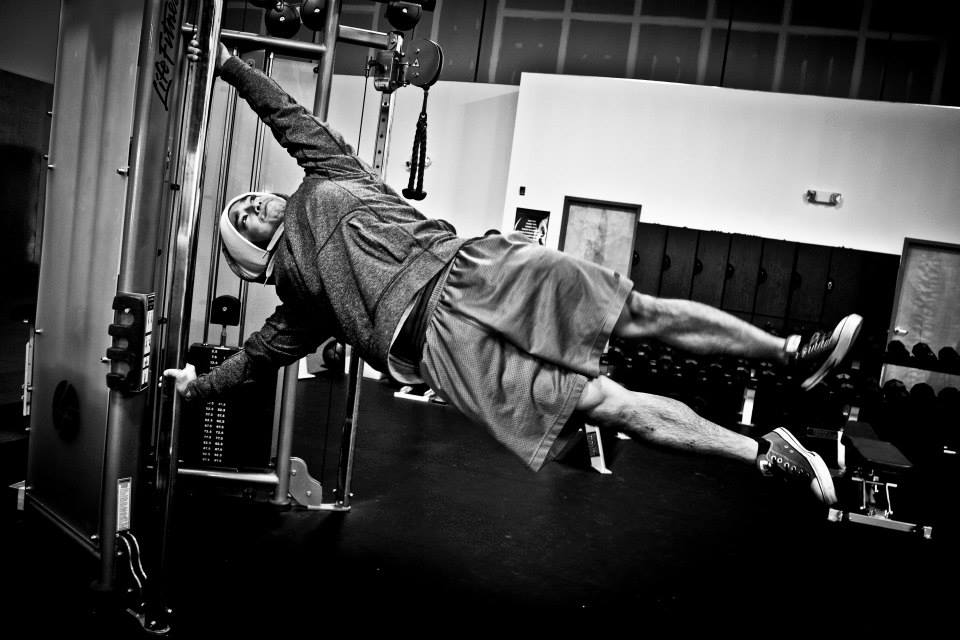I tend to hyperanalyze things. Hyper, in the sense that I have the tendency to extrapolate things out – not out of proportion, merely draw all the steps out in any given situation. This has its benefits – I can begin to tell you a few reasons why I don’t gamble in poker or blackjack, for example. It also has its negatives – as with any type of “overthinking”, there is the downward spiral of thinking that involves angst related worrying.

With this in mind, I tend to take the stance of taking action instead of going down that road of anxiety.
What if I miss my macros by 20g of protein? I missed my fasted cardio this morning because I overslept by 20 minutes. I can’t make up for it because I’m traveling and then I’ll be too tired from driving all day this week.
So, instead of worrying, I’d rather gather my losses, plan ahead to not make that same mistake, and move on.
With this in mind, I’m not a fan of excuses, complaining or general talk about “I coulda, shoulda, woulda…” I’ve always appreciated that to get results that matter, you need to put in some work. I’ve also always appreciated that in order to get great results you need to fall in love with the process of achieving greatness.
One thing I can understand is that not everyone is of the same mindset, and some of us do in fact use that “coulda/shoulda/woulda” talk. And I respect that, because everyone goes through different mental bouts or struggles.
However, once you go through whatever method of therapy you choose to go through, the question then remains – what is your next move? Sitting on a psychological problem and hemming and hawing won’t achieve any visceral results. Go see a therapist already. That is what they are there for – to talk with and figure things out. Or resolve your issue in person, whatever the issue is.
After you figure it out, you can now begin the process of achieving real results.
One question I ask myself almost daily is, “What is limiting you?”
For Howard Stark, his limitations in technology within his current time limited him from creating a new element – in which his son, Tony Starks, portrayed by Robert Downey Jr., later discovered with the help of his father’s work.
Superhero movie talk aside, there is something fascinating to me about making due with what your current resources currently have. Obviously optimal is the ideal mindset, but what will you do if you don’t have the resources for every little detail planned to the “T”?
Here is an off-the-cuff, no excuses list of things you can do for 30 minutes for the fitness-stressed individual.
What I included were a few logical rationale if anyone has any barriers towards these actions, along with the specific timeframes that these items would take me to perform. For others, it may take longer of course.
One of the missing points when comparing apples to apples is that sometimes the process for a result is misunderstood, or simply not hashed out. It is when a plan can be reverse engineered that a goal can be achieved.
I have a dream fantasy of appearing in a kung fu action flick. However, this would take years of practicing tricking, perhaps some type of martial arts (what a thought!), along with developing the network that would allow me to do so. I am on a different path, perhaps adjacent to, but not directly in line with me performing in a specific situation such as this.
However, fitness and health, for whatever reason, are thrown upon some pedestal with which it may be impossible to “achieve” such fitness. It does not have to be, and I outlined several bulletpoints that have rationale along with the process towards achieving success in “fitness”.
Physical List of Things to Do
1. Perform foam rolling, purposeful breathing exercises, and a dynamic warm-up. (Time = 15 minutes)
- Foam rolling has several benefits towards improving range of motion, increasing ischemic blood flow to hypoxic tissue, and decreasing neurological tension in some muscle groups.
- Positional breathing drills have several important implications, largely aiming to reduce sympathetic tone, and improving neurological positioning of muscles.
- A dynamic warm-up can improve blood flow to specific muscle groups, improve neurological movement patterns, along with improving movement quality of mobility-deprived joints.
2. Perform KB Swings and Push-Ups in a ladder or circuit-like fashion. (Time = 10-20 minutes)
- For a circuit: Perform 10 KB Swings, and then 10 push-ups. Rest for 60 seconds. Perform for 8 to 10 sets.
- For a ladder: Perform 1 KB Swing, and 1 push-up. Rest for 60 seconds. After, perform 2 KB swings, and 2 push-ups. Rest for 60 seconds. Repeat to 10 KB Swings, 10 push-ups. When you reach 10/10, go back down the “ladder”.
3. Perform positional breathing drills, jump rope, and then deadlift. (Time = 30 minutes)
- Breathing Drills = 5 Minutes (to get into a better position)
- Jump Rope = 3-5 Minutes (to work up a sweat)
- Deadlift (or insert large compound movement) = 20 minutes
- Work up to a heavy set, or do multiple sets at a lower percentage of 1RM.
Psychological/Mental List of Things to Do
1. Examine your triggers and learn why you may be destroying your fitness oriented efforts. (Time = 1-30+ minutes)
- Reflecting introspectively why you behave the way you do can be a bit foreign to those not used to thinking like this, so let me walk you through the process.
- First, identify negative habit. (My habit is over-eating carbs at night.)
- Next, identify why habit may exist. (Perhaps I am bored, need to appease my oral fixation while watching TV, reading too much and want a mental break, or am simply hungry.)
- Provide solutions to curb negative habit. (Get rid of carbs from surroundings, put a timeline on reading to prevent staying up later than necessary, or find a more satiety-oriented food that will help curb appetite – such as increasing protein sources.)
2. Go for a walk around your neighborhood. (Time = 5-30+minutes)
- Instead of looking at your phone/laptop as soon as you wake up, put your phone on airplane mode when you wake up, and take a walk.
- The arbitrary act of walking is not the end goal, rather it is the means with which to increase blood flow throughout the circulatory system globally.
- Also, nature is beautiful. Look around once in a while, hear the birds sing, and smell some fresh air.

3. Delete numbers, defriend/delete Facebook/Twitter/Instagram/etc. (Time = 5-30 minutes, depending on amount of contacts; or 10 seconds to delete your social media apps)
- Reduce your digital footprint in order to declutter your necessity to cling to “things”, your “identity”, and decrease your need for social media triggers.
- If you don’t have Facebook/Twitter/Instagram on your phone, you won’t use it, check it, and won’t have anything to worry about. It’ll be like pre-2005 all over again.

4. Turn your phone off, and ask your significant other how they are doing. (Time = 5 seconds to turn phone off, 5 seconds to ask your family/friend/significant other how they are doing)
- Care about those who surround you immediately. Often the “now” is lost for fear of missing out, fear of loss, anxiety, etc.
- If you don’t have a phone to check on others, what will you identify with?
- See Fight Club anachronism,
“You are not your phone/job/car/physique.”
5. Text or call your family/friend/significant other and tell them “I love you.” (Time = 5 seconds to text, 5 seconds to 30+ minutes to wait for response; although that isn’t the point.)
- See above.
6. Read a book/download podcasts that will mentally stimulate and/or challenge your current thought process. (Time = 5 to 30+minutes, depending on length of podcast/book, and you can pick up where you left off relatively easy.)
- Your thoughts shape how you act.
- If you don’t have any thoughts, how will you act?
Nutritional List of Things to Do
1. Learn how to cook. (Time = 5-30+minutes, although for minimum effective doseage, it is fairly simple to pick up this skill. For further enhancement of “cooking” for flavor, style, and other items, it is a lifelong skill.)
- Foster an attitude of independence, and take responsibility for what is entering your body nutritionally.
- Food is energy.
- If you can’t cook, do you know the source of your energy?
2. Cook chicken/beef/[insert protein source]. Throw some veggies in a pan and boil for a few minutes. (Time = Approximately 30 Minutes)
- Chicken takes 5 minutes to prep, 20-25 minutes to bake, and 5 minutes to chop up and put in a Tupperware for later.
- Boiling veggies simultaneously while you bake your chicken will allow you to save time.
3. Identify what foods are negative triggers (that you have in your immediate surrounding or that you enjoy) towards binging, and make a physical note of them (or gather them). (Time = 5-30 minutes)
4. Raid your fridge, pantry, and under your bed for everything that is a negative trigger that will cause you to go down a downward spiral from a healthy eating point of view. (Time = 30+ minutes)
- Getting rid of triggers is a crucial habit that many do not identify with regards to improving habits.
- Recovering alcoholics generally do not bode well being surrounded by alcohol.
- Should you surround yourself with negative triggers if you are attempting to curb a habit of overeating?
5. Make smoothies consisting of fruits, protein powder, and/or greens. (Time = 10-20 minutes)
- Instead of wholly getting rid of negative habits, only to have other habits rear their head in its place, replace the negative habit with a positive habit.
- Identify a well intentioned protein source, greens supplement, and locally grown fruit/veggies.
Recovery List of Things to Use/Buy
1. Buy a sleep mask to block out light. (Time = < 5 minutes)
- By blocking out light, you are reducing your visual input that is interpreted via your brain, which in essence should reduce your sympathetic tone.
- Less input = more parasympathetic =better sleep.
- Amazon.com has a lot of options. And you don’t need to leave your seat/phone to do it.
2. Buy ZMA, melatonin, and/or magnesium – all natural supplements – to aid with sleep and calming your nervous system down. (Time = < 5 minutes)
- ZMA on Examine.com
- Examine.com’s Stack Guides on Sleep and Recovery have more information on how these supplements can help aid with sleep.
3. Buy a red light to aid with sleep. (Time = < 5 minutes)
- “Red or amber light doesn’t appear to wreck melatonin and sleep as much as blue or white light.” ~Anthony Mychal
Hopefully these are some helpful tips to get you going towards a healthier lifestyle.
Notice that there is no motivational video here to get you started in the morning. To me, those may serve as mental masturbation videos that do nothing but to get you fired up – but do nothing to give you an actionable plan towards achieving real results.
Also notice that there is no running listed as a form of “exercise”.
Personally, I don’t like running.
As always,
Keep it funky.
MA


